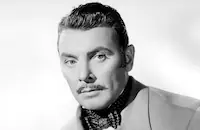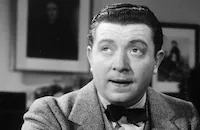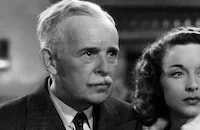Wings of the Navy

Brief Synopsis
Cast & Crew
Lloyd Bacon
George Brent
Olivia De Havilland
John Payne
Frank Mchugh
John Litel
Film Details
Technical Specs

Synopsis
Brothers Cass and Jerry Harrington are both carrying on the proud Navy tradition of their father, who was killed in the service. Older brother Cass serves as a lieutenant in the Naval air force, while Jerry is a submarine ensign. Deciding that he wants to be a pilot, Jerry gets a transfer to the Naval air school in Pensacola, Florida, against the opposition of Cass, who worries that his younger brother will feel pressured by the competition. Nevertheless, Jerry joins the class at Pensacola with cadets Dan Morrison, Scat Allen and Armando Costa. After completing his schooling, Jerry is assigned to the Naval base in San Diego, where Cass is also stationed. When Cass leaves for Washington to sell his plane design to the government, Jerry falls in love with Irene Dale, Cass's fiancée. Although Irene returns Jerry's love, circumstances dictate that she remain with Cass after he is crippled in a crash during a training flight and is forced to resign from the service. Soon after, Jerry wins his wings, is promoted to lieutenant and given the command of a bomber bound for Honolulu. As Jerry prepares to leave, the plane designed by Cass undergoes rigorous testing. As a group of assembled officials watch in horror, the test pilot crashes during a power dive. The plane seems doomed when other pilots refuse to complete the testing, and Jerry, realizing that the plane represents life to Cass, resigns his commission to complete the last test. Jerry passes out during a dangerous dive, but regains consciousness just in time to land safely, thus proving the value of the craft. Awarded another commission, Jerry is in the process of taking off for Honolulu when Cass realizes that Irene is in love with his brother and frees her to marry him.

Director

Lloyd Bacon
Cast

George Brent

Olivia De Havilland

John Payne

Frank Mchugh

John Litel

Victor Jory

Henry O'neill

John Ridgely

John Gallaudet
Donald Briggs
Edgar Edwards

Regis Toomey
Albert Morin

Jonathan Hale

Pierre Watkin

Don Douglas
Max Hoffman
Alan Davis

Larry Williams

Lee Phelps
Selmer Jackson

Joseph Crehan

Ed Keane

Walter Miller
Alexander Lockwood
Tony Hughes
Le Roy Samuels
Fred Hamilton
Morgan Conway
Gaylord Pendleton
Virginia Brissac
Richard Bond
Will Morgan

Rosella Towne
William Moore

George Meeker
Jack Gardner

Howard Hickman

William Davidson
Max Wagner
Mary Gordon

Emmett Vogan
Renie Riano
Carlyle Moore Jr.
Ed Parker
Crew
George Amy
Elmer Dyer
Lou Edelman
Arthur Edeson
Michael Fessier
Leo F. Forbstein
Esdras Hartley
Byron Haskins
William Holmes
H. F. Koenekamp
Richard Mayberry
Orry-kelly
Francis J. Scheid
Hugh Sease, Lieutenant Commander, U.s.n.
Jack L. Warner

Videos
Movie Clip



Trailer
Film Details
Technical Specs

Articles
Wings of the Navy
Director Lloyd Bacon made 73 films of all kinds during his long career at Warner Bros. - comedies, melodramas, musicals, westerns - but his favorites were action pictures. He loved the Navy, and made several films about it. Bacon often said, "You can't get too much action in a motion picture," and when he was making Wings of the Navy, he added, "And you can't get too much Navy in a picture either, particularly one demanding excitement."
So incidental was the love story in Wings of the Navy that Olivia de Havilland was having serious doubts about her career at Warner Bros. She had gotten off to a great start in 1935, with her debut film, A Midsummer Night's Dream, and an inspired pairing with Errol Flynn in Captain Blood, which led to more films with him, including The Adventures of Robin Hood (1938). But too often, she was cast as the generic love interest in movies where the men had all the fun, and she considered her role in Wings of the Navy as another of those. While working on her next picture, Dodge City (1939) she was close to a nervous breakdown. Deciding to take matters into her own hands, de Havilland aggressively went after the role of Melanie in Gone With the Wind (1939), and convinced Jack Warner to loan her out for it. In spite of the acclaim she earned for her performance, it was back to business as usual when she returned to Warner Bros., and she eventually took the studio to court, winning a landmark decision that freed her from her contract.
A song written for Wings of the Navy, "Wings Over the Navy," by Harry Warren and Johnny Mercer, became a popular hit in England, which would soon be at war. Warren had written songs for some of Warner Bros.' greatest early 1930s musicals, including 42nd Street (1933, also directed by Bacon), and Gold Diggers of 1933. Wings of the Navy would be Warren's last film for Warner Bros.
Reviewers praised the aviation sequences in Wings of the Navy, and were generally bored by the romance. The New York Times critic wrote, "The story is the least conspicuous part of the picture. As a documentary study of the Pensacola Naval Air Training station, and its methods of turning raw recruits into seasoned pilots of combat and bombing planes, Wings of the Navy gets off the ground very nimbly...the educational part is so interesting that we return to the romantic part...with a feeling akin to pain." Time Magazine was more succint: "Loud buzz of airplane motors, interrupted occasionally by George Brent, John Payne, and Olivia de Havilland."
Producer: Louis Edelman
Director: Lloyd Bacon
Screenplay: Michael Fessier
Cinematography: Arthur Edeson
Film Editing: George Amy
Art Direction: Esdras Hartley
Music: Heinz Roemheld, Harry Warren
Cast: George Brent (Lt. Cmdr. Cass Harrington), Olivia de Havilland (Irene Dale), John Payne (Lt. Jerry Harrington), Frank McHugh (Scat. Allen), John Litel (Cmdr. Clark), Victor Jory (Lt. Parsons).
BW-90m.
by Margarita Landazuri

Wings of the Navy
Quotes
Trivia
Notes
Although onscreen credits list George Amy as film editor, the Film Daily review credits William Holmes as editor. The onscreen credits list no producer credit, and the reviews conflict over who produced this film. Film Daily credits Jack Warner and Hal Wallis as producers and Lou Edelman as associate producer. Hollywood Reporter credits Hal Wallis as executive producer and omits Edelman. According to the Variety review, this picture, a Cosmopolitan Production, benefitted from the publicity machinery of the Hearst publishing empire. The picture was shot on location at the Pensicola, FL and San Diego, CA naval air stations. In October 1940, George Brent and Olivia de Havilland starred in a Lux Radio Theater version of the story.















